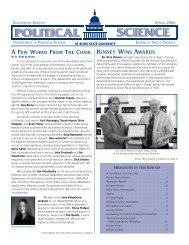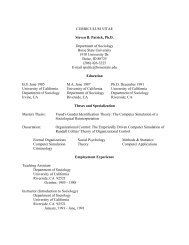Late Glacial Environments and Paleoecology at Blackwater Draw ...
Late Glacial Environments and Paleoecology at Blackwater Draw ...
Late Glacial Environments and Paleoecology at Blackwater Draw ...
You also want an ePaper? Increase the reach of your titles
YUMPU automatically turns print PDFs into web optimized ePapers that Google loves.
82 CHRISTOPHER L. HILL, FRED WENDORF, PAUL B. SEARS AND EDNA PAPAZIAN<br />
while there are higher proportions of Artemisia, Graminae,<br />
Compositae <strong>and</strong> the Cheno-Ams in the younger<br />
section of the zone. Very low amounts of certain taxa<br />
are not shown on the simplified pollen diagram, including:<br />
Cyperaceae, Rosaceae, Typha, Polygonum,<br />
Rhamnaceae, Plantago, Caryophllaceae, Guttiferae,<br />
Haloragidaceae, Umbelliferae, Ranunculaceae, Rhus,<br />
Anacardiaceae, Moraceae, Sparganum, Potamogeton,<br />
Loranthaceae, Corylus, Rumex, <strong>and</strong> Cuscuta.<br />
The mollusc assemblage from unit B2 <strong>at</strong> the nearby<br />
Highway Site (LA 3325) contains freshw<strong>at</strong>er bivalves<br />
(Pisidium casertanum <strong>and</strong> P. casertanum), aqu<strong>at</strong>ic<br />
snails (Gyraulus cf. circumstri<strong>at</strong>us) <strong>and</strong> a terrestrial<br />
snail (Vallonia cf. cyclophorella) (Drake 1975:211).<br />
Overlying unit B2 <strong>at</strong> the Barrow Pit is a facies of<br />
unit D with an age of about 10,600 B.P., based on radiocarbon<br />
measurements of shells (Haynes 1975). Seven<br />
samples from this str<strong>at</strong>um were analyzed for pollen.<br />
Arboreal pollen is domin<strong>at</strong>ed by Pinus; it constitutes<br />
from about thirty to nearly sixty percent of the identifiable<br />
pollen. Other arboreal pollen present in small<br />
amounts include Betula, Quercus, <strong>and</strong> Picea. There<br />
are minor occurrences of Ulmus, Celtis, Juglans, Pl<strong>at</strong>anus,<br />
Acer, Ostrya, Carya, Nyssa, Fraxinus, <strong>and</strong> Castanea<br />
not shown on Fig. 3. Non-arboreal pollen is<br />
domin<strong>at</strong>ed by Ambrosia (about 20% of identifiable<br />
pollen) in the lower section of unit D <strong>and</strong> Artemisia<br />
(around 30% of identifiable pollen) in the top section.<br />
Compositae, Graminea, <strong>and</strong> the Cheno-Ams are persistent<br />
throughout unit D. Low frequencies of Rosaceae,<br />
Typha, Polygonum, Rhamnaceae, Caryophllacae, Hypericum,<br />
Myriophyllum, Urtica, Araliaceae, <strong>and</strong> Cruciferae<br />
(= Brassicaceae) also occur.<br />
At the nearby Highway Site (LA 3325) molluscs<br />
probably from unit D (Haynes 1975) include Sphaerium<br />
sulc<strong>at</strong>um <strong>and</strong> Helisoma anceps, suggesting permanent<br />
w<strong>at</strong>er, although the presence of Promenetus<br />
exacuous, Helisoma trivolvis, Stagnicola cf. exilis, Planorbula<br />
cf. armigera, <strong>and</strong> Gyraulus cf. circumstri<strong>at</strong>us<br />
suggest less permanent w<strong>at</strong>er (Drake 1975:209). Some<br />
of the molluscs indic<strong>at</strong>e cooler temper<strong>at</strong>ures than<br />
present (Promenetus exacuous, Gyraulus cf. circumstr<strong>at</strong>es,<br />
Armiger cistra, <strong>and</strong> Pupilla muscorum). Molluscs<br />
typical of woodl<strong>and</strong> conditions include: Vertigo<br />
ov<strong>at</strong>a, Nesovitrea electrina, Euconulus fulvus, <strong>and</strong> Vallonia<br />
cf. cyclophorella. The overall molluscan assemblage<br />
appears to reflect ecological conditions associ<strong>at</strong>ed<br />
with grassy or open woodl<strong>and</strong>s (Drake 1975:209).<br />
A lacustrine sediment from LA 3325/Locality 7 contained<br />
Pinus, Picea, Artemisia, Tubuliflorae, Liguliflorae,<br />
Gramineae, <strong>and</strong> Chenopodiaceae (Schoenwetter<br />
1975). Pine values reach 35%, while Artemisia values<br />
reach 25%. This sample has been considered as representing<br />
the Tahoka Pluvial (the local equivalent of the<br />
Last <strong>Glacial</strong> Maximum) or an older clim<strong>at</strong>e episode<br />
(Oldfield <strong>and</strong> Schoenwetter 1975).<br />
OTHER PALEOECOLOGICAL EVIDENCE<br />
FROM UPPER BLACKWATER DRAW<br />
Blackw<strong>at</strong>er <strong>Draw</strong> Locality No. 1 (Clovis gravel pit;<br />
LA 3324, Locality 12, Hester 1975; Haynes 1975). This<br />
locality has been extensively studied because it contains<br />
a str<strong>at</strong>igraphic sequence with Clovis, Folsom, <strong>and</strong> other<br />
artifacts as well as Rancholabrean faunal remains<br />
(Hester 1972). It is situ<strong>at</strong>ed about 2 miles (3.2 km)<br />
north of the Barrow Pit locality.<br />
There are several d<strong>at</strong>es from deposits str<strong>at</strong>igraphically<br />
below the speckled s<strong>and</strong>s or unit B deposits <strong>at</strong><br />
the gravel pit th<strong>at</strong> appear to constrain the age of the<br />
str<strong>at</strong>igraphic sequence <strong>at</strong> the Barrow Pit. Lacustrine<br />
carbon<strong>at</strong>es <strong>at</strong>tributed to the Tahoka Pluvial (design<strong>at</strong>ed<br />
str<strong>at</strong>um B in Holliday 1995) are younger than about<br />
21,100 B.P. (SMU-2533), <strong>and</strong> other ages of 22,930 B.P.<br />
(AA-7093) <strong>and</strong> 17,220 B.P. (AA-7092) (Haynes 1995)<br />
limit the age of overlying sediments (cf. Haynes 1975,<br />
Unit B1; also termed the “speckled s<strong>and</strong>” or the “gray<br />
s<strong>and</strong>” cf. Antevs 1949, Hester 1972). These ages imply<br />
th<strong>at</strong> the unit B1 <strong>and</strong> B2 deposits from the Barrow<br />
Pit d<strong>at</strong>e to the l<strong>at</strong>e Last <strong>Glacial</strong> Maximum or the early<br />
part of the <strong>L<strong>at</strong>e</strong> <strong>Glacial</strong>.<br />
Samples collected from the gravel pit in the 1930s<br />
were submitted to P. Sears for analysis. The samples<br />
contained pine pollen th<strong>at</strong> Sears concluded may have<br />
been present due to long distance transport (Hester<br />
1972:24). Where pollen was preserved in unit B1<br />
(“gray s<strong>and</strong>”) taxa included Pinus, Ulmus, Artemisia,<br />
Graminae, <strong>and</strong> Chenopodiacea (Schoenwetter 1975).<br />
Fauna from the “gray s<strong>and</strong>” contains large <strong>and</strong> small<br />
vertebr<strong>at</strong>es. In terms of ecological interpret<strong>at</strong>ions, the<br />
large vertebr<strong>at</strong>es typically provide regional-scale inform<strong>at</strong>ion<br />
while smaller vertebr<strong>at</strong>es provide inform<strong>at</strong>ion<br />
on local conditions. Carnivores include Canis lupus,<br />
C. l<strong>at</strong>rans, C. dirus, Vulpes velox, Smilodon californicus.<br />
Other large vertebr<strong>at</strong>es include Pl<strong>at</strong>ygonus,<br />
Camelops, Tanupolama macrocephala, Bison antiquus,<br />
three species of Equus (E. conversidens, E. niobrarensis,<br />
E. scotti), <strong>and</strong> Mammuthus. Stable isotope measurements<br />
of Bison indic<strong>at</strong>e the regional presence of<br />
C4 (warm clim<strong>at</strong>e) grasses, but Mammuthus isotopes<br />
displayed two distinct p<strong>at</strong>terns (Connin et al. 1998;<br />
Hoope 2004). Some of the samples appear to reflect<br />
cooler glacial conditions while other measurements<br />
reflect an increase in warmer clim<strong>at</strong>e grasses (Connin<br />
et al. 1998; Hoope 2004).<br />
Some fossils are from extinct animals; their value<br />
as direct environmental indic<strong>at</strong>ors is not as strong as<br />
remains from animals th<strong>at</strong> are still living <strong>and</strong> thus have<br />
clim<strong>at</strong>e <strong>and</strong> range tolerances th<strong>at</strong> can be measured.<br />
The presence of Ond<strong>at</strong>ra zibethica indic<strong>at</strong>es the presence<br />
of permanent w<strong>at</strong>er <strong>and</strong> more evenly distributed<br />
annual rainfall, while the extinct Terrapene canalicul<strong>at</strong>a<br />
may imply some wooded areas (Lundelius 1972).







